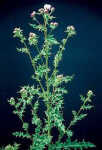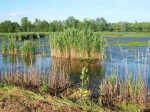Weeds unfazed by continuing drought

McCOOK, Nebraska -- Despite the continuing drought in Southwest Nebraska, and particularly in Red Willow County, weeds continue to grow, well ... hmmm ... like weeds.
Bill Elliott, the county's weed control specialist, told county commissioners during their weekly meeting Monday morning that he continues to inspect sprayed and uncontrolled infestations of musk and Canada thistles, salt cedar, phragmites and leafy spurge, and now, even a weed called "houndstongue" or "dog bur."
"Houndstongue isn't a noxious weed," Elliott said, so spraying of it can't be enforced. But it, and another obscure weed called lespedeza, are becoming issues, he said.

According to "Weeds of Nebraska and the Great Plains," houndstongue contains an alkaloid that causes liver cells to stop reproducing. Sheep are less susceptible than cattle or horses to poisoning; horses are particularly susceptible if they're confined in a corral in which houndstongue grows. The burs cling to sheep's wool, reducing its value, and they cause dermatitis in humans.
Leafy spurge got a boost in the county when hay trucks traveled Highway 83 last spring and summer, heading to drought-stricken livestock in Oklahoma and Texas and dropping leafy spurge seeds along the way. Near Hugh Butler Lake, in particular, bales that caught fire on trailers were unloaded and firefighters doused them in the road ditch and in a pasture. "Leafy spurge is going to be an issue, I'm afraid," Elliott said, although, he added, the state's Department of Roads is doing a good job of controlling it.
Phragmites is becoming more of a focus of state weed control efforts, Elliott said. Phragmites showed up on the Republican River in Red Willow, he said, when a landowner transplanted cattails from a pond on the Platte River, and got phragmites in the bargain. Most of the phragmites in the county is west of Perry. It has to be sprayed in the fall.

The usual battles continue between landowners and Canada and musk thistle. Elliott said one landowner has what he calls "an 'unusual canyon.' Musk thistle likes to grow in the bottom. This is growing on top."
Another landowner is trying to spray his thistle, but he's being careful not to kill his trees as well. Others are working to control noxious weeds growing in CRP.
Control of salt cedar on the Republican will be complemented by efforts of the Southwest Weed Management Area. Some growths of salt cedar will be spot-sprayed, Elliott said.
County-owned properties are not exempt from the growth of noxious weeds. Reports from Jeff Lampmann, an ag inspection specialist with the Department of Agriculture/Bureau of Plant Industry, indicate that the county has, in several locations, infestations of musk and Canada thistle, phragmites and salt cedar. They'll be sprayed at the appropriate times, Elliott said.
Lampmann worked with Elliott in McCook Aug. 7, and will return to re-inspect infestations and report updates in the fall.
Elliott is using a new "weed mapper" system and camera that pinpoints the GPS (global positioning system) location of a weed and creates a file and/or report for Elliott's files, for county commissioners and for the state. Elliott says the new system will provide better accountability and public awareness of where noxious weeds are growing in the county
